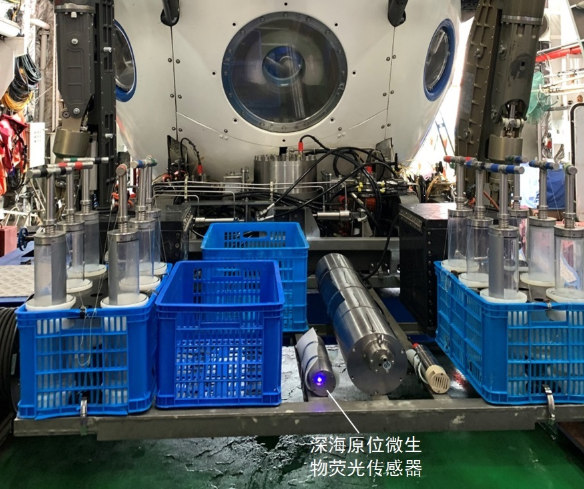[ Instrument R & D of Instrument Network ] A few days ago, the three deep-sea in-situ fluorescence sensors developed by Dalian Institute of Chemical Engineering, Chinese Academy of Sciences, were recently successfully tested in the South China Sea Scientific Examination. It is reported that this is China's first deep-sea in-situ fluorescence sensor of this type. Among them, the deep-sea in-situ microbial fluorescence sensor is the first international instrument of this type. It is understood that in situ detection of the concentration of polycyclic aromatic hydrocarbons in the deep sea is helpful for the exploration of crude oil spills on the seabed, and has important energy exploration value. Let's take a look!

Deep sea in-situ microbial fluorescence sensor, pictured from Dalian Institute of Chemical Physics, Chinese Academy of Sciences
On April 14, the Dalian Institute of Chemical Physics, Chinese Academy of Sciences (hereinafter referred to as "Dalian Institute of Chemical Physics") disclosed that recently, three prototypes of China's deep-sea in-situ fluorescence sensor engineering have been tested on the Deep Sea Warrior / Exploration No. 1 TS16 South China Sea scientific expedition Among them, the manned submersible equipped with the "Deep Sea Warrior" has carried out 11 underwater tests, with a maximum diving depth of 3497.6 meters. It is reported that this is China's first deep-sea in-situ fluorescence sensor of this type. Among them, the deep-sea in-situ microbial fluorescence sensor is the first international instrument of this type.
It is understood that these three sensors were jointly developed by the team of researcher Guan Yafeng and associate researcher Geng Xuhui and the Institute of Deep Sea Science and Engineering of the Chinese Academy of Sciences (hereinafter referred to as the "Deep Sea Institute").
According to reports, the series of sensors include deep-sea in-situ chlorophyll fluorescence sensors, deep-sea in-situ microbial fluorescence sensors and deep-sea in-situ polycyclic aromatic hydrocarbon fluorescence sensors. Previously, after testing by the deep sea, these three sensors have passed the water purification pressure test, and the maximum working depth is 4500 meters.
During the maritime trial of the voyage, the deep-sea in-situ chlorophyll fluorescence sensor conducted a total of 5 submarine subsea tests with a maximum test depth of 3497.6 meters; the deep-sea in-situ microbial fluorescence sensor conducted a total of 3 submarine subsea tests with a maximum test depth of 2371.4 meters; The deep-sea in-situ polycyclic aromatic hydrocarbon fluorescence sensor has conducted a total of 3 submarine subsea tests, with a maximum test depth of 3340.0 meters.
According to reports, the series of sensors respectively measured the concentration of chlorophyll a, microorganisms and polycyclic aromatic hydrocarbons in the entire section of the South China Sea from sea level to the bottom. In situ detection of the concentration of chlorophyll a in the deep sea reflects the biomass or existing stock of phytoplankton in the deep sea and is the basis for calculating primary productivity. Detecting the concentration of microorganisms in the deep sea in situ has high scientific research value and derived economic value.
According to the Dalian Institute of Chemical Industry, in-situ detection of the concentration of polycyclic aromatic hydrocarbons in the deep sea is helpful for the exploration of crude oil spills on the seabed and has important energy exploration value. The data obtained from this exploration provides important raw data for multi-disciplinary research such as marine biology and physical oceanography.
Submerged arc welding is one of the most widely used mechanical welding methods in various industrial sectors, especially in shipbuilding, power generation equipment, boiler pressure vessels, large pipelines, rolling stock, heavy machinery, bridges, and oil refining and chemical equipment production. Technology has played a positive role in promoting the development of the welding structure manufacturing industry.
Submerged Arc Welding Wear Plate
submerged arc welding plate
JIANGSU WELLDAM WEAR-RESISTING INDUSTRIAL CO.,LTD , https://www.wedwearplate.com